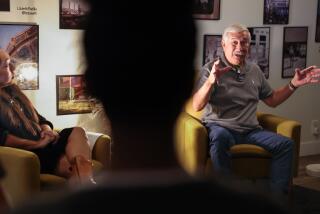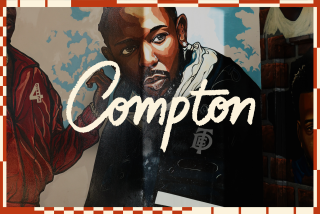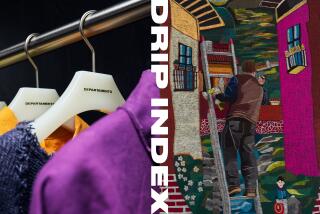Wan Joon Kim of Cycadelic Records helped gangsta rappers start
By the time Bobby Wilson met Wan Joon Kim, he’d been to 15 record stores.
It was 1994, and no one would stock his cassette, “Comin’ From Watts,” with raps Wilson had written in prison and recorded himself upon his release. Wilson had a daunting resume: a decade-long membership in the Grape Street Watts Crip gang; five years incarcerated for attempted murder; the prison nickname “Kill Kill.”
Just out on parole and desperate for money to support his wife and child, Wilson’s last stop was the Compton Fashion Center indoor swap meet.
Kim, the owner of the Cycadelic record stall, was in his 50s, spoke little English and liked classical music. But he stocked what sold: the music of young rappers who were chronicling the crack-and-gang-addled neighborhoods around them. He took a chance on Wilson. “I think he understood my struggle, more than anything,” said Wilson, 42. After all, “he’s in the heart of Compton.”
PHOTOS: Hip-hop gone Hollywood?
The cassette sold close to 15,000 copies over the next year. Wilson went on to become an underground rap star. Kim “gave me my shot,” said Wilson. “It saved my life.”
While the world knows of the major L.A. gangsta rap figures who helped popularize the raw urban genre two decades ago — Suge Knight, Dr. Dre, Ice Cube — a far less likely figure pushed the music long before most folks knew it existed. If it came straight outta Compton, the birthplace of gangsta rap, often it first went through Wan Joon Kim.
The L.A. riots of 1992 created an indelible image of Korean immigrant shop owners in urban neighborhoods often in conflict with their African American customers, but that was hardly the whole story. “Most of my customers were the gang-bangers and drug dealers, so I built a friendship with them,” said the now frail Kim, 79, in an interview interpreted by his son, Kirk. His son now runs the stall, selling Latin music to a changing demographic. Kim works there once a week. “They were good to me as I was good to them.”
New country, new sounds
Wan Joon Kim escaped his native North Korea in 1950, sailing down the coast to South Korea with his family in his father’s fishing boat. In 1976, he and his wife, Boo Ja, and their three young children were among the first waves of immigrants who left South Korea for Los Angeles.
At first, Kim and his wife sold women’s hair clips and barrettes at outdoor swap meets around Southern California. While selling at the Roadium Open Air Market in Torrance, Kim noticed that the man selling records always had a line.
Then in 1985, a few Korean swap-meet vendors leased an empty Sears building in Compton, partitioned it, and renamed it Compton Fashion Center — thus inventing the indoor swap meet in Southern California, said Edward Chang, a UC Riverside ethnic studies professor, who has researched swap meets in the Korean business community. Later, dozens of indoor swap meets opened, virtually all of them Korean-owned, and became malls for the inner city. Their stalls were the doors through which thousands of new Korean immigrants entered the L.A. business world, without bank loans.
Kim was selling barrettes at an outdoor swap meet one day when “the owners were coming around to individual vendors, saying they were going to open a bigger, nicer place,” he said.
Kim envisioned it as an easier way of doing business than traveling every day to a new swap meet, so he was third in line when Compton Fashion Center began leasing to vendors. He chose Stall Z-7, the spot nearest the building’s main entrance, with a monthly rent of $500.
A wholesaler suggested he sell the R&B;, gospel, funk and rap coming from New York, though he eventually developed an ear for black music — and his own customers’ tastes — aided by his second daughter, Jinna Grace, who worked at the store and spoke English. When a song hit the radio, he drove quickly to wholesalers and had it in the store within hours.
Kim opened for business just as crack invaded Compton. Gunplay ruled the streets. “Several shootings happened here,” Kim said, indicating the entrance to the swap meet.
But amid the chaos, a hive of kids were mixing tapes in cramped apartments and garages, rapping and sampling like famous New York rappers. “They didn’t know nothing about signing to a record label, so they made music for their own neighborhood,” said Arlandis Hinton, who grew up in Compton and raps as BG Knocc Out. “That’s where they took it, to the Compton swap meet. He was like their first distributor.”
Its themes of drug dealing and the thug life made gangsta rap intensely controversial, and many record stores wouldn’t touch it at first. But it met about the only criteria that mattered in the microcapitalist world of the indoor swap meet: It sold.
Traffic and sales skyrocketed. Compton rappers delivered him new product constantly, and he became known to them all as “Pops” and his wife as “Mama.” Gangsta rap paid for the Kim daughters’ classical piano lessons, as the family moved from Koreatown to Gardena, then to Orange County.
“Everyone from everywhere was coming — artists and customers. People from Riverside, Pasadena,” Kim said. “Since wholesalers were so close, any time a song came on the radio people would come by real fast. I would drive and get it and sell it that day. We didn’t have to order and wait for shipping.”
Eric “Eazy-E” Wright, who started Ruthless Records to record his raps and that of his seminal group, N.W.A, would bring Kim his 12-inch singles. Boo Ja Kim treated rappers like her children and would scold: “Eric, pull your pants up!”
Changing with the times
In the 1990s, the black population began leaving Compton. Gangsta rap also left the confines of the city to become an international genre. Wright died of AIDS. Crack and gang shootings would take the lives of numerous other rappers who sold their first productions through Cycadelic Records.
But Bobby Wilson survived, saved from prison by the career started at Cycadelic Music. He now raises pigeons in Lancaster and publishes a magazine about the birds.
“He didn’t have to give me money for those cassettes the way he done it,” Wilson said. Kim “opened the door for everybody that was struggling.”
Cycadelic has also hung on, partly because of a clientele that continues to drive in from around Southern California. Today, Kim’s son, Kirk, is using Facebook and EBay to sell product worldwide. He stocks a large selection of Chicano gangsta rap — with rappers such as Lil G and Ms Krazie — a reflection of Compton’s new population.
With free Internet downloads, sales aren’t close to what they were during his dad’s heyday, but he sends his product to Hong Kong as easily as to Montana. And he still takes in demos from aspiring rappers; only now he hopes to promote them in Japan, where rap out of Compton is big and Cycadelic Music is a legendary name.
Large indoor swap meets pioneered at Compton Fashion Center remain largely Korean owned and have spread across Los Angeles to the Inland Empire — some three dozen in all. Others have expanded into the Central Valley and Las Vegas. Nowadays, though, new Korean immigrants have a vast Korean community, including banks and large companies, which they can tap to find their first jobs and business opportunities.
These days, Wan Joon Kim spends only a day a week at his stall. It is lined with old photos of him and his wife with then-young Compton rappers like DJ Quik and the late Mausberg with their game faces on. There’s also one of Shaquille O’Neal, whose 1993 album, “Shaq Diesel,” sold poorly at Cycadelic, but Kim remembers him fondly.
Yet after almost half a lifetime of selling one of pop’s most incendiary genres, it’s unclear how much Wan Joon Kim ever understood of the raps that passed through his store.
“This music I don’t like,” he said, through his son. “But I understand where they come from. They’re speaking from their hearts and their minds. I understand that.”
More to Read
The biggest entertainment stories
Get our big stories about Hollywood, film, television, music, arts, culture and more right in your inbox as soon as they publish.
You may occasionally receive promotional content from the Los Angeles Times.










